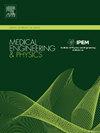A numerical simulation study of airway flow: Impact of bronchial stenosis
IF 1.7
4区 医学
Q3 ENGINEERING, BIOMEDICAL
引用次数: 0
Abstract
Obstructive lung diseases, marked by airway stenosis, are chronic and pose significant mortality risks. This study aims to analyze airflow patterns in obstructed bronchi, comparing them to healthy airways during tidal breathing to improve our comprehension of disease effects on respiratory function. The current studies mostly overlook the specific morphology of the patient's upper airway or the elastic deformation of the airway soft tissues, which results in the existing results not being sufficient to effectively guide surgical treatment. In this paper, a realistic model of bronchial stenosis was obtained by CT data from a 71-year-old female patient. Full consideration was given to the nonlinear elastic material properties of the tracheal wall cartilage and smooth muscle and the dynamic changes in intra-pulmonary pressure, which are significant factors affecting the airflow field within the airway. The dynamic mesh technology and the Fluid-Structure Interaction (FSI) method, in conjunction with Computational Fluid Dynamics (CFD), were employed to analyze the impact of bilateral bronchial stenosis on the airflow state and the nonlinear mechanical behavior of the airway wall under different respiratory intensities. The simulation results exposed the distribution pattern of key parameters, such as airflow velocity, pressure, wall shear stress, and turbulent kinetic energy, indicating that bronchial stenosis significantly influences the air-flow motion, resulting in increased pressure, wall shear stress, and deformation of the airway wall. The finding revealed that the maximum airflow velocity, pressure, and wall shear stress all occurred in the stenosis areas of the bronchi, while the maximum deformation occurred on the smooth muscle side of the middle part of the main trachea. Additionally, turbulence occurs near the main trachea and carina, potentially related to airflow separation and local geometric changes. These insights contribute to a deeper understanding of the effects of bronchial stenosis on airway airflow dynamics and provide a scientific basis for the determination of clinical treatment plans and the prediction of treatment outcomes.

气道流动的数值模拟研究:支气管狭窄的影响
以气道狭窄为特征的阻塞性肺疾病是慢性的,具有显著的死亡风险。本研究旨在分析阻塞支气管的气流模式,并将其与潮汐呼吸时的健康气道进行比较,以提高我们对疾病对呼吸功能影响的理解。目前的研究大多忽略了患者上气道的具体形态或气道软组织的弹性变形,导致现有的研究结果不足以有效指导手术治疗。本文通过对一位71岁女性患者的CT资料,获得了一个真实的支气管狭窄模型。充分考虑了气管壁软骨和平滑肌的非线性弹性材料特性以及肺内压力的动态变化,这是影响气道内气流场的重要因素。采用动态网格技术和流固耦合(FSI)方法,结合计算流体力学(CFD)方法,分析了不同呼吸强度下双侧支气管狭窄对气道气流状态和气道壁非线性力学行为的影响。仿真结果揭示了气流速度、压力、壁面剪应力、湍流动能等关键参数的分布规律,表明支气管狭窄对气流运动有显著影响,导致气道壁面压力、壁面剪应力增大,气道壁面变形。结果显示,最大的气流速度、压力和壁面剪切应力均发生在支气管狭窄区域,最大的变形发生在主气管中部的平滑肌侧。此外,湍流发生在主气管和隆突附近,可能与气流分离和局部几何变化有关。这些见解有助于更深入地了解支气管狭窄对气道气流动力学的影响,为确定临床治疗方案和预测治疗结果提供科学依据。
本文章由计算机程序翻译,如有差异,请以英文原文为准。
求助全文
约1分钟内获得全文
求助全文
来源期刊

Medical Engineering & Physics
工程技术-工程:生物医学
CiteScore
4.30
自引率
4.50%
发文量
172
审稿时长
3.0 months
期刊介绍:
Medical Engineering & Physics provides a forum for the publication of the latest developments in biomedical engineering, and reflects the essential multidisciplinary nature of the subject. The journal publishes in-depth critical reviews, scientific papers and technical notes. Our focus encompasses the application of the basic principles of physics and engineering to the development of medical devices and technology, with the ultimate aim of producing improvements in the quality of health care.Topics covered include biomechanics, biomaterials, mechanobiology, rehabilitation engineering, biomedical signal processing and medical device development. Medical Engineering & Physics aims to keep both engineers and clinicians abreast of the latest applications of technology to health care.
 求助内容:
求助内容: 应助结果提醒方式:
应助结果提醒方式:


